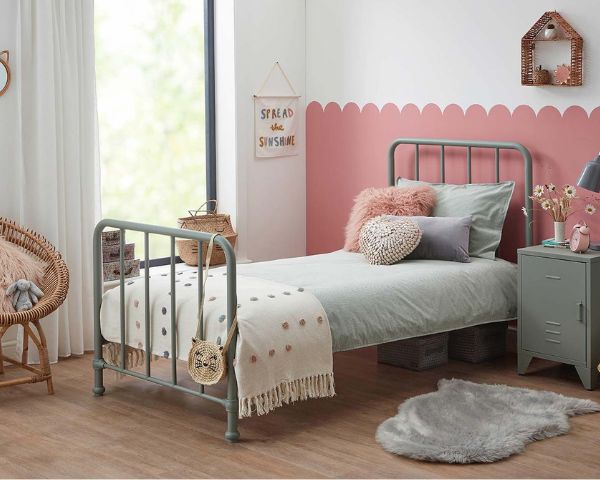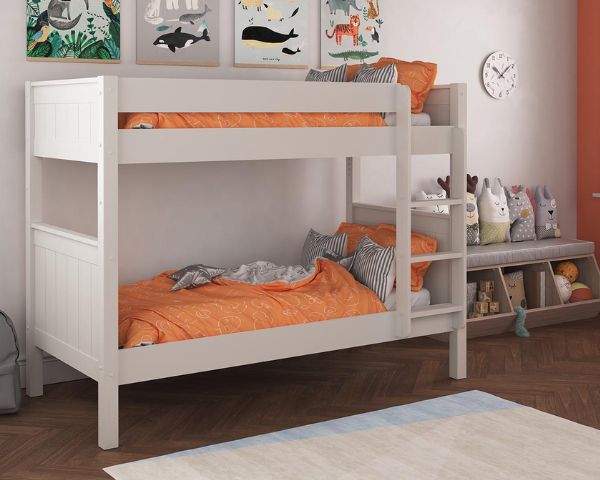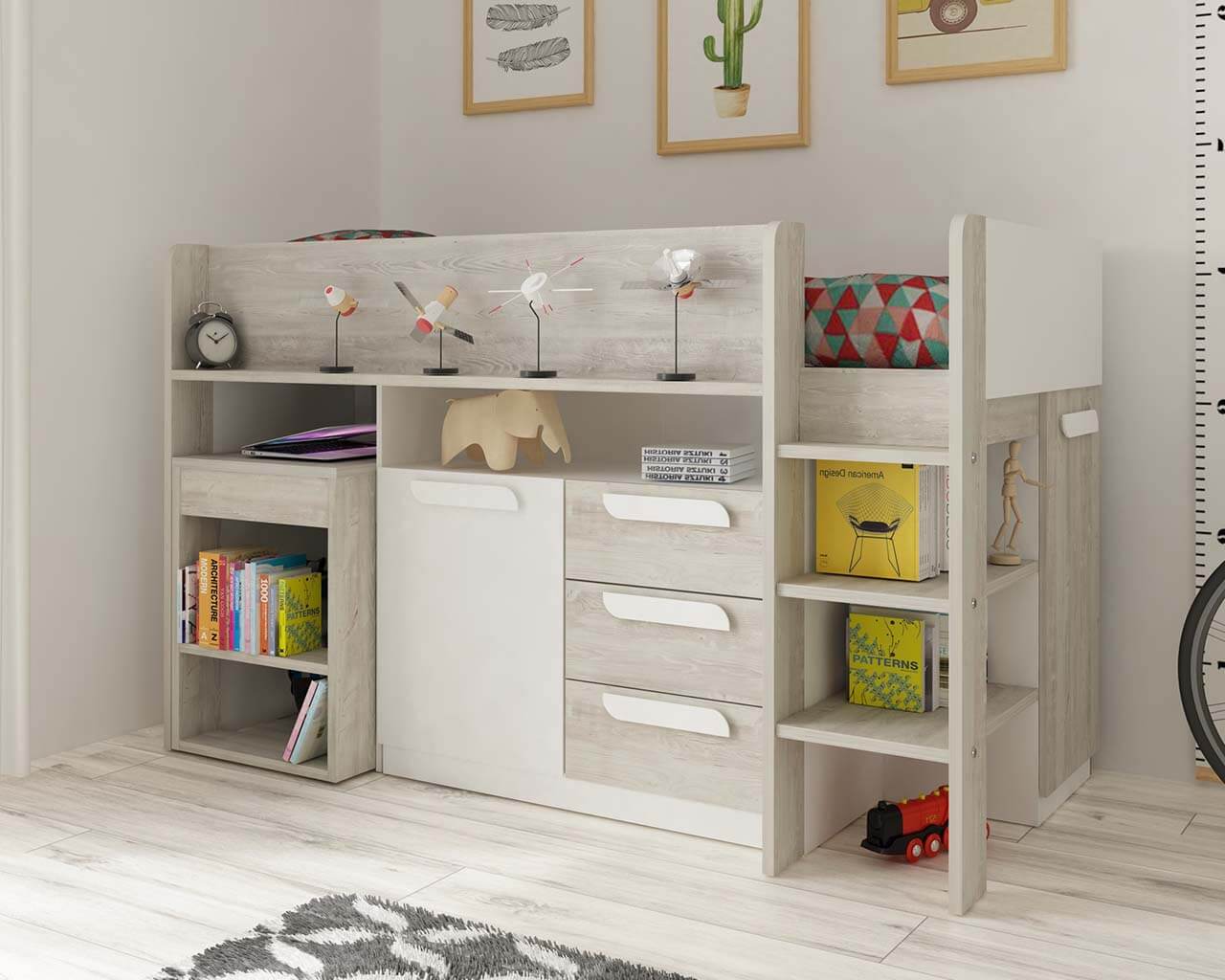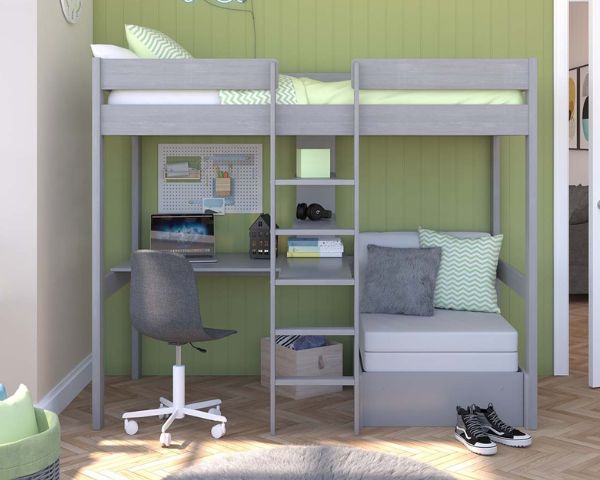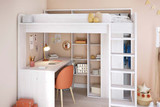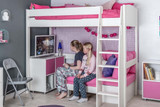The Pros and Cons of Different Types of Kids' Beds
We know when it comes to choosing the right children’s bed it’s a decision that involves comfort, safety, style, and functionality. To help in your selection process we've put together a guide to the pros and cons of different types of kids' beds. So, let's delve into the details and make this process a bit easier for you.
Single Beds
The Pros of a Single Bed are:
- Space–Saving: Single beds are perfect for smaller bedrooms or rooms with limited space. They offer ample sleeping space for your child without overcrowding the room. With a single bed, you can efficiently arrange other bedroom furniture, such as a study desk, wardrobe, or toy storage, making the most of the available space.
- Transition Friendly: Single beds are versatile and adaptable, making them a great long-term investment. They can accommodate your child from their toddler bed right through to their teenage years. As your child grows, you can easily update the room's decor without needing to change the bed. This adaptability is both cost-effective and convenient.
- Cost -Effective: Single beds are often more budget-friendly than larger options. This affordability is particularly useful if you're working within a budget or need to purchase multiple beds for more than one child.
The Cons of Kids Single Beds are:
- Limited Space: While single beds work well for younger children, they can start to feel a bit cramped as your child grows taller or becomes a teenager. This may necessitate an upgrade to a larger bed in the future.
- Challenges with Sleepovers: If your child enjoys hosting sleepovers, a single bed may not provide enough sleeping space for guests. You may need to invest in a trundle bed or have an additional mattress available for such occasions.
- Potential for Outgrowing the Bed's Style: As your child's tastes and preferences evolve, they may outgrow the design, particularly if it’s a themed single bed. This could lead to a desire for a more mature or personalised bedroom setup, which may involve changing the bed itself.
Bunk Beds
The Pros of Kids Bunk Beds:
- Space Maximisation: Bunk beds are an excellent solution for smaller bedrooms or rooms with limited floor space. By stacking two beds vertically, they effectively free up valuable floor space for other furnishings or activities.
- Accommodate Siblings or Sleepovers: Bunk beds are a practical choice for families with multiple children sharing a room. They allow siblings to have their own sleeping space within the same room. Bunk beds are also great for sleepovers, as they provide an extra bed without taking up additional room space.
- Adventure and Fun: Children often find climbing up and down the ladder or stairs to the top bunk an exciting and enjoyable part of their bedtime routine. Bunk beds can make bedtime a bit more fun.
- Built-In Storage: Many bunk beds come with built-in storage features such as drawers, shelves, or cubbies. This integrated storage helps keep the bedroom organised and reduces clutter.
The Cons of Bunk Beds:
- Safety Concerns: It's crucial to ensure that the top bunk has sturdy guardrails and to teach your children about safe usage.
- Not Suitable for all Ages: Younger children may struggle with the top bunk, so consider their age and maturity. The recommended age for the top bunk is 6+ years
- Limited Headroom on Lower Bunk: The lower bunk may have limited headroom, which could be uncomfortable for taller children or adults sitting on the bottom bunk.
Cabin Beds and Mid Sleepers
The Pros of Cabin Beds and Mid Sleeper Beds:
- Space Utilisation: Cabin beds are renowned for their space-saving design. They combine a bed with various storage options, a desk, or play area, effectively maximising the available bedroom space. The raised platform of a cabin bed creates valuable under-bed space that can be used for storage, a desk, or additional seating.
- Multi-Functional: These beds are designed to serve multiple functions, which can include sleeping, studying, reading, and even playing. This versatility makes cabin beds an excellent long-term investment.
- Organisation and Storage: Cabin beds typically come with built-in storage solutions, including drawers, shelves, cupboards, and even a wardrobe. This allows for efficient organisation of your child's belongings, promoting a tidy and clutter-free room.
- Encourage Independence: Midsleepers promote independence and responsibility in children by providing them with their own designated space for studying, playing, and storing their possessions.
The Cons of Cabin beds and Midsleeper Beds:
- Initial Investment: Cabin beds can be more expensive than standard single beds due to their integrated features and built-in furniture components. The initial cost may be a concern for some families.
- May Outgrow Design: As children's interests and needs change, they may outgrow the design or functionality of a cabin bed. This could necessitate updates or a change to a different bed type as they grow older. However, there are still plenty of options for older children and teens.
High Sleepers or Loft Beds
Pros of High Sleepers or Loft Beds:
- Space Maximisation: High sleeper beds or loft beds are excellent at maximising the use of vertical space. By elevating the sleeping area, they free up valuable floor space underneath, which can be used for various purposes, such as a study desk, play area, or additional storage.
- Versatility: These beds are highly versatile and can be customised to fit your child's specific needs. You can configure the under-bed space to include a study desk, shelving, a wardrobe, or even a seating area, allowing for a multifunctional bedroom setup.
- Transition Friendly: High sleeper or loft beds are suitable for a wide age range, from young children (6+) to teenagers. As your child grows, you can adapt the under-bed space to accommodate their changing interests and requirements.
- Organisation and Storage Solutions: Many high sleeper or loft beds come with built-in storage options, such as drawers, shelves, or a wardrobe. These features help keep the room organised and reduce clutter. They’re a great choice for kids beds with storage.
- Space for Play and Creativity: The space under a high sleeper or loft bed offers a designated area for play and creative activities. It can be transformed into a play fort, a cosy reading nook, or an art and craft space, stimulating your child's imagination.
- Maximises Floor Space: By raising the sleeping area, high sleeper or loft beds free up floor space, allowing for more activities and storage within the room. This is especially beneficial in smaller bedrooms.
Cons of High Sleeper or Loft Beds:
- Room Height Requirement: High sleeper or loft beds require sufficient ceiling height in the room to accommodate the elevated sleeping area. This might not be possible in rooms with low ceilings.
- Assembly and Installation: Setting up a high sleeper or loft bed can be more time-consuming and complex compared to traditional single beds due to the elevated design and additional components. Proper installation is vital for safety.
- Challenges for Changing Bed Linens: Making the bed on the elevated sleeping platform can be more challenging, as it may require extra effort or dexterity to reach all corners of the mattress.
- Potential for Outgrowing Design: Children's interests and needs change as they grow. Your child may eventually outgrow the design or functionality of the high sleeper or loft bed, necessitating an update or a switch to a different type of bed.
- Accessibility for Younger Children: While high sleeper or loft beds are generally safe, young children might have difficulty climbing up and down the ladder or stairs to access the sleeping area. Safety precautions and supervision are important in such cases. The recommended minimum age for a high bed is 6+.
To summarise, when choosing a kids bed, you need to consider the age of your child, their needs, available space, and budget. Safety should always be a top priority, and ensuring that your child is comfortable and content in their new bed is crucial.
So, create a checklist, involve your child in the decision-making process, and enjoy the journey of finding the perfect bed that will ensure sweet dreams and peaceful nights for years to come. Happy bed shopping!
Recent Posts
-
Unlocking the Potential of High Sleeper Beds for Teenagers
As teenagers go through all the ups and downs of being a teen, their likes and dislikes change a lot
-
Choosing Between a High Sleeper Bed vs. Mid Sleeper Bed
As your little one grows, so do their needs, and finding the perfect kids’ bed for them becomes








